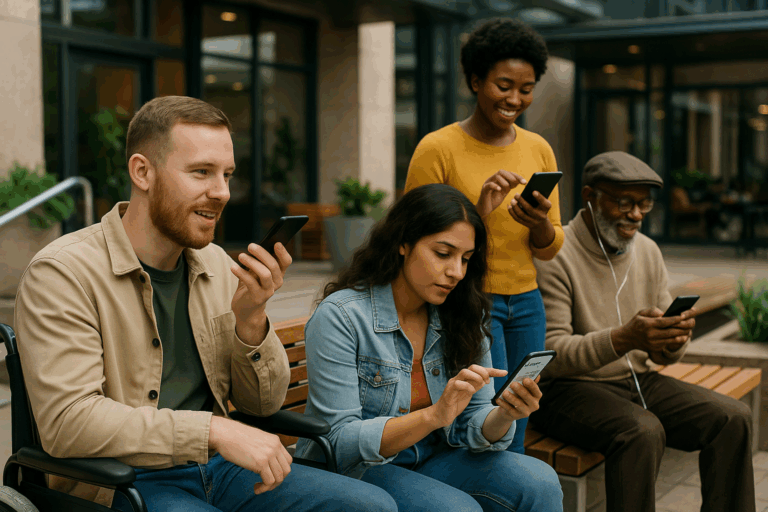No longer is it enough for a space, be it physical or digital, to be aesthetically pleasing—it also needs to be accessible. Enter the concept of Inclusive Design. This design philosophy is no passing fad. It’s a necessity, a moral obligation, and a catalyst for creativity.😃
However, a common hurdle many businesses face is the perceived financial burden of implementing inclusive design strategies. But what if I told you that it doesn’t have to be as costly as you might think? 🤔 In this article, we’ll explore the concept of Budget-Friendly Inclusive Design and the strategies you can employ to create accessible spaces for everyone—without breaking the bank.
The Intersection of Inclusive Design and Budget Constraints
Inclusive Design aims to create environments that cater to the needs and experiences of as many individuals as possible, regardless of their age, gender, ability or cultural background. But, here’s the catch – achieving this goal within budget constraints can seem like a daunting task.
Rest assured, though, cost-effective inclusive design is not only possible—it’s also potentially more profitable in the long run. In this article, we’ll take you through a deep dive into the world of inclusive design on a budget, providing practical strategies and tips that will benefit not only your bottom line, but also your diverse range of users.💡
Budget-Friendly Inclusive Design: Not an Oxymoron
Many companies shy away from inclusive design, assuming it’s an expensive venture. However, the truth is, the cost of excluding potential customers due to inaccessible design can far outweigh the initial investment in making your space more inclusive.
On the surface, inclusive design may seem like a cost-intensive exercise, but a closer look reveals that it’s a strategic decision that can save resources, increase your reach, and promote brand loyalty. In this blog post, we’ll share some game-changing tips and strategies to help you get started on your journey to a more inclusive—and budget-friendly—design.👍
What to Expect
Curious about what’s in store? We’ll begin by demystifying inclusive design and explaining why it’s an investment worth making. We’ll explore why budget-friendly inclusive design isn’t as elusive as it seems, and we’ll share practical, actionable tips to help you design inclusively, irrespective of your budget constraints.
Expect to gain insights on how to align your design strategies with the principles of inclusive design, without needing to exhaust your budget. We’ll show you how small, thoughtful changes can create a significant impact on the accessibility of your spaces—be they physical or digital.🎯
Whether you’re a seasoned professional or a novice in the field of design, this blog post aims to provide you with the knowledge and tools you need to champion inclusive design on a budget. Get ready to learn how to make your spaces more accessible and engaging, without compromising on aesthetics or functionality—and all of this, without breaking the bank! 💪
So, buckle up as we dive into the world of Budget-Friendly Inclusive Design: Strategies for Creating Accessible Spaces for All. This journey promises to be enlightening, empowering, and yes, economically savvy. Let’s get started!
Understanding the Importance of Inclusive Design
In today’s modern world, the importance of inclusive design cannot be overstated. Inclusive design is a methodology that involves designing products, services, and environments to be accessible and usable by as many people as possible. It considers all aspects of human diversity and individuality, including age, gender, ethnicity, and physical and mental abilities. Inclusive design has a crucial role in creating a more equitable world, and it’s beneficial not only for individuals with disabilities but for everyone. For a more detailed explanation of inclusive design, check out the video below from ‘InVisionApp’ YouTube channel: “Inclusive Design: From Accessibility to Aesthetics”.
However, a common misconception is that implementing inclusive design is expensive, and thus not feasible for small businesses or individuals with a tight budget. This article aims to debunk this myth, providing strategies for creating accessible spaces for all without breaking the bank.
Before diving into the strategies, let’s take a look at a comparative table that shows the differences between inclusive design, universal design, and accessible design. This comparison will give a better understanding of the unique qualities of inclusive design.
| Design Type | Description | Key Principle |
| Inclusive Design | A design approach that ensures products and services are accessible and usable by as many people as possible. | Design for diversity and inclusivity. |
| Universal Design | A design approach that aims to make products and environments accessible and usable by all people, to the greatest extent possible, without adaptation. | Design for everyone. |
| Accessible Design | A design process in which the needs of people with disabilities are specifically considered. | Design for accessibility. |
Strategies for Budget-Friendly Inclusive Design
While inclusive design is critical, it doesn’t have to be prohibitively expensive. There are numerous cost-effective strategies that can be implemented to create spaces that are accessible and welcoming for all. The following sections will explore these strategies in detail.
1. Engage with Diverse Users
One of the most effective ways to ensure your space is inclusive is by engaging with a diverse range of users during the design process. Seek input from individuals with different backgrounds and abilities, and consider their needs and preferences when making design decisions. This approach not only helps create an inclusive environment but can also save money in the long run by avoiding costly redesigns or modifications.
2. Invest in Flexible Furniture
Flexible furniture is a cost-effective investment that can greatly enhance the inclusivity of a space. This includes adjustable tables, chairs with varying heights, and modular seating that can be rearranged to accommodate different needs. Investing in such pieces may have a slightly higher upfront cost, but their adaptability will pay off over time.
3. Use Color and Contrast Wisely
Color and contrast are powerful tools for enhancing accessibility. High-contrast color schemes can make text and signage more readable for those with visual impairments, while thoughtful color choices can create a more welcoming and calming environment. This strategy requires no additional cost, just a more thoughtful approach to color selection.
Examples of Budget-Friendly Inclusive Design
Now that we’ve explored some strategies, let’s look at real-world examples of budget-friendly inclusive design. These examples prove that inclusive design doesn’t have to be expensive; it just requires creativity, empathy, and an understanding of diverse user needs.
1. The British Museum, UK
The British Museum, despite being one of the oldest and most prestigious institutions in the world, has made significant strides in inclusive design. They’ve achieved this by implementing simple, cost-effective measures like clear signage, wide walkways, and wheelchair ramps. The museum also offers tactile experiences, allowing visually impaired visitors to touch certain exhibits, enhancing their museum experience at no extra cost.
2. eSSENTIAL Accessibility
eSSENTIAL Accessibility is a digital accessibility solutions provider that helps organizations create inclusive digital experiences. They offer a free assistive technology app for individuals with physical disabilities, enabling them to navigate the web more easily. This illustrates how inclusive design can be cost-effective and beneficial for both users and businesses.
3. The Ramp House, Scotland
The Ramp House in Scotland is a unique example of inclusive residential design. This home was designed for a family with a wheelchair user and incorporates a continuous ramp into the design. This cost-effective design solution not only enhances accessibility but also adds to the aesthetic appeal of the home.
Inclusive Design Tools and Resources
To further assist you in your budget-friendly inclusive design journey, here are some useful tools and resources. These will help you gain a deeper understanding of inclusive design principles and provide practical guidance on how to implement them in your projects.
- Microsoft Inclusive Design Toolkit: This comprehensive toolkit from Microsoft provides a wealth of information and resources on inclusive design. It includes guidelines, case studies, and practical tips for implementing inclusive design.
- The A11Y Project: This community-driven project offers a collection of resources to help you create more accessible digital products. They offer checklists, tutorials, and articles on a range of accessibility topics.
- Color Contrast Checker: This free online tool allows you to test color combinations for sufficient contrast, making it easier to design a visually accessible space.
Remember, inclusive design isn’t about spending a lot of money. It’s about making thoughtful design decisions that consider the diversity and individuality of all users. By implementing these budget-friendly strategies, you can create spaces that are not only accessible and inclusive, but also add value to your business or organization.

Conclusion
Wrapping Up
We’ve traversed a complex but fascinating journey through the intricacies of Software Engineering. We’ve delved into the principles that govern this domain, exploring various software development methodologies, languages, frameworks, and other critical aspects. We’ve also touched on the importance of continuous learning in this field, given the rapid pace of technology evolution.
The key points discussed serve as a roadmap to the broad landscape of Software Engineering. The methodologies, such as Agile, DevOps, and Waterfall, provide different approaches to software development, each with its unique strengths and weaknesses. The choice of methodology can significantly impact the project’s efficiency and success, hence understanding these nuances becomes paramount.
Similarly, our discussion on programming languages and frameworks provided an insight into the tools that are at the disposal of a software engineer. It’s essential to remember that the choice of language or framework depends on various factors like the project requirements, the team’s expertise, and the long-term maintenance considerations.
Finally, we highlighted the necessity of keeping up with the technological advancements in the industry. As software engineers, our learning never stops. 📚 The more we embrace this ethos, the more adept we become at navigating the challenges posed by the evolving tech landscape.
Understanding these elements and their interplay is vital to anyone involved in software development. Whether you’re a seasoned software engineer, a project manager, or a budding programmer, this knowledge can profoundly impact your work.
So, take a moment to reflect on these concepts. Think about how you can apply them in your day-to-day work, improving your efficiency and delivering better results. And remember, sharing is caring! If you found this article helpful, don’t forget to share it with your peers.💡
Feel free to comment below with your thoughts, ideas, or questions. I’d love to hear from you. Also, if you want to delve deeper into any of these topics, check out these resources:
- ScienceDirect: Software Development Methodologies
- IEEE Xplore: Recent Trends in Programming Languages
- Computer Society Digital Library: Evolution of Software Engineering Frameworks
Let’s keep the conversation going. Together, we can demystify Software Engineering, one concept at a time! 💪



